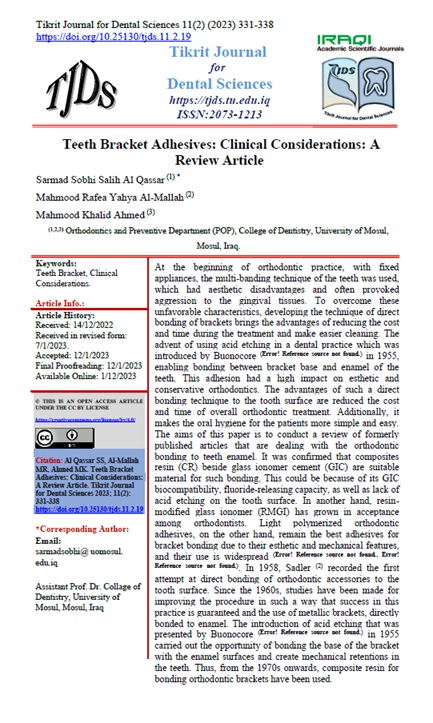Teeth Bracket Adhesives: Clinical Considerations: A Review Article
Sarmad Sobhi Salih Al Qassar
Orthodontics and Preventive Department (POP), College of Dentistry, University of Mosul, Mosul, Iraq.
Mahmood Rafea Yahya Al-Mallah
Orthodontics and Preventive Department (POP), College of Dentistry, University of Mosul, Mosul, Iraq.
Mahmood Khalid Ahmed
Orthodontics and Preventive Department (POP), College of Dentistry, University of Mosul, Mosul, Iraq.
DOI: https://doi.org/10.25130/tjds.11.2.19
Keywords: Teeth Bracket, Clinical Considerations.
Abstract
At the beginning of orthodontic practice, with fixed appliances, the multi-banding technique of the teeth was used, which had aesthetic disadvantages and often provoked aggression to the gingival tissues. To overcome these unfavorable characteristics, developing the technique of direct bonding of brackets brings the advantages of reducing the cost and time during the treatment and make easier cleaning. The advent of using acid etching in a dental practice which was introduced by Buonocore (Error! Reference source not found.) in 1955, enabling bonding between bracket base and enamel of the teeth. This adhesion had a high impact on esthetic and conservative orthodontics. The advantages of such a direct bonding technique to the tooth surface are reduced the cost and time of overall orthodontic treatment. Additionally, it makes the oral hygiene for the patients more simple and easy. The aims of this paper is to conduct a review of formerly published articles that are dealing with the orthodontic bonding to teeth enamel. It was confirmed that composites resin (CR) beside glass ionomer cement (GIC) are suitable material for such bonding. This could be because of its GIC biocompatibility, fluoride-releasing capacity, as well as lack of acid etching on the tooth surface. In another hand, resin-modified glass ionomer (RMGI) has grown in acceptance among orthodontists. Light polymerized orthodontic adhesives, on the other hand, remain the best adhesives for bracket bonding due to their esthetic and mechanical features, and their use is widespread (Error! Reference source not found., Error! Reference source not found.). In 1958, Sadler (2) recorded the first attempt at direct bonding of orthodontic accessories to the tooth surface. Since the 1960s, studies have been made for improving the procedure in such a way that success in this practice is guaranteed and the use of metallic brackets, directly bonded to enamel. The introduction of acid etching that was presented by Buonocore (Error! Reference source not found.) in 1955 carried out the opportunity of bonding the base of the bracket with the enamel surfaces and create mechanical retentions in the teeth. Thus, from the 1970s onwards, composite




